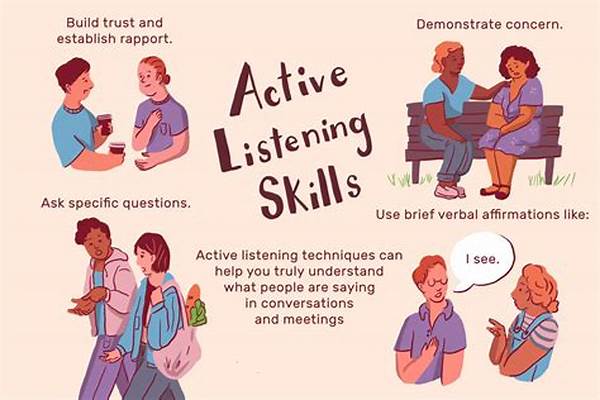In the realm of interpersonal relationships, communication serves as the cornerstone of understanding and connection. One of the pivotal elements that enhance communication is active listening. For couples, mastering active listening techniques can significantly improve the quality of their interactions, diminish misunderstandings, and fortify the emotional bond between partners. This article delves into the nuances of active listening techniques for couples, offering insights and strategies to cultivate a more empathetic and understanding relationship.
Read Now : Timeless Romantic Historical Themes
Importance of Active Listening in Relationships
Active listening techniques for couples are integral in fostering an environment wherein both partners feel heard and valued. Communication is not merely about speaking but also involves an active effort to comprehend the other’s perspective. When couples engage in active listening, they partake in a process that necessitates full attention, empathy, and a non-judgmental stance. This approach allows individuals to respond thoughtfully and constructively, rather than impulsively reacting, thereby mitigating conflicts and fostering harmony. Ultimately, active listening creates a safe space for open dialogue, enhancing emotional intimacy and trust.
Furthermore, employing active listening instills a sense of respect and validation. Couples who practice this technique exhibit greater satisfaction in their relationships, as it encourages the expression of sentiments and genuine understanding. Active listening techniques for couples enable partners to acknowledge and embrace each other’s differences, leading to a more cohesive partnership. Therefore, it is imperative for couples to adopt and continuously refine their active listening skills to nurture a thriving relationship.
Core Elements of Active Listening Techniques
1. Maintaining Eye Contact: Establishes connection and shows attentiveness, validating the speaker’s importance and promoting open communication.
2. Reflective Listening: Involves paraphrasing or summarizing what the speaker has expressed, ensuring understanding and demonstrating empathy.
3. Non-Verbal Cues: Body language, such as nodding or leaning slightly forward, reinforces attentiveness and engagement.
4. Avoiding Interruptions: Allows the speaker to complete their thoughts, preventing misunderstandings and fostering mutual respect.
5. Asking Clarifying Questions: Demonstrates genuine interest in understanding the speaker’s viewpoint, facilitating deeper discussion.
Enhancing Empathy through Active Listening
Active listening techniques for couples serve as a catalyst for nurturing empathy within a relationship. When partners sincerely engage in active listening, they deliberately place themselves in their partner’s shoes, striving to comprehend emotions and viewpoints that may differ from their own. This empathetic approach delineates the path toward deeper emotional connections, as partners feel genuinely understood and valued.
Empathy, cultivated through active listening, empowers partners to acknowledge and appreciate each other’s experiences and emotions. By doing so, couples are better equipped to tackle challenges collaboratively, as they recognize the significance of each partner’s feelings. Active listening techniques for couples thus pave the way for creating a supportive and understanding dynamic, where partners thrive both individually and collectively.
Practical Applications of Active Listening
Exploring the practical aspects of active listening techniques for couples can prove transformative in their daily interactions. Consider the following strategies:
1. Prioritize active listening during routine conversations.
2. Consciously avoid distractions, such as mobile devices, when engaging in discussions.
3. Validate each other’s emotions without judgment.
Read Now : Techniques For Improving Auditory Focus
4. Employ reflective listening to ensure comprehension.
5. Allocate time for regular conversations, even amidst busy schedules.
6. Utilize open-ended questions to encourage detailed responses.
7. Acknowledge and respect different perspectives while maintaining composure.
8. Recognize non-verbal signals and adjust responses accordingly.
9. Emphasize positive reinforcement when acknowledging partner’s efforts.
10. Commit to continuous improvement in active listening skills.
Building Trust through Active Listening
Active listening techniques for couples are a cornerstone in the construction of trust within relationships. The practice of giving undivided attention and showing genuine interest in the partner’s narrative conveys a powerful message of respect and commitment. When partners are assured that their thoughts and emotions will be received without judgment, it creates a mutually respectful environment that bolsters trust exponentially.
Furthermore, through active listening, couples learn to navigate conflicts with understanding and patience. Misunderstandings and disagreements are approached with a willingness to listen and comprehend before reacting. This practice reduces conflict escalation and nurtures a collaborative problem-solving mindset. Consequently, active listening techniques for couples lay the foundation for a resilient and trusting relationship, rendering it an indispensable element of a successful partnership.
Continual Improvement in Active Listening
The journey of mastering active listening techniques for couples is ongoing—a continuous process of learning and adaptation. Partners must remain committed to refining their listening skills, acknowledging the importance of this effort in sustaining a healthy relationship. As the dynamics of a relationship evolve, so too must the strategies employed in active listening.
Consistency in applying active listening techniques facilitates the growth of understanding and empathy between couples, encouraging a deeper emotional bond. As partners invest time and effort into active listening, they cultivate an atmosphere where both feel seen, heard, and cherished. In essence, active listening techniques for couples epitomize the shared journey of nurturing love and understanding, encouraging relationships to thrive and blossom.
